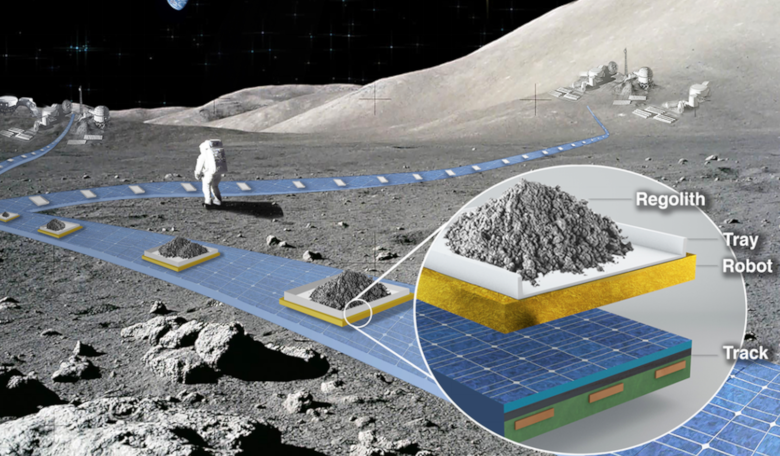In its bid to revolutionise new kinds of missions, NASA has selected a number of advanced space concepts that will receive grants for further research and development, including a lunar levitation track system, swimming micro-robots for exploring ocean worlds, a method for making soil from asteroid material and a Titan sample return mission using in-situ propellants.
These futuristic space ideas have been put forward by researchers at the agency’s own Jet Propulsion Laboratory, along with more than a dozen other scientists and candidates from industry and academia. Each will receive grants worth up to $125,000 from the NASA Innovative Advances Concepts (NIAC) programme to explore their concepts' feasibility.
“NIAC Fellows are known to dream big, proposing technologies that may appear to border science fiction and are unlike research being funded by other agency programs,” said Jenn Gustetic, director of early-stage innovations and partnerships within NASA’s Space Technology Mission Directorate (STMD). “We don’t expect them all to come to fruition but recognise that providing a small amount of seed-funding for early research could benefit NASA greatly in the long run.”
Past NIAC projects have included an innovative mission to view the surface of exoplanets using small sats and the Lunar Crater Radio Telescope (LCRT) – a vast radio telescope concept deployed to a crater on the far side of the Moon that was proposed by Saptarshi Bandyopadhyay.
If Bandyopadhyay's novel LCRT concept does not come to full fruition, then NASA could still build an observatory on the Moon but this time using a sparse array of around 100,000 dipole antennas populating an approximate 20 x 20 kilometre area.
Dubbed FarView, the very large low frequency (5-40 MHz) radio observatory is a concept proposed by Ronald Polidan at Lunar Resources, Inc.
Polidan envisages that Farview would also be built on the lunar farside, but this time using lunar regolith materials.
“This radio telescope will be the first of its kind at this scale and sensitivity and will open a new window (low frequency radio) into the early universe, analogous to the detection of gravitational waves by LIGO and the details of the CMB by Planck,” says Polidan in his proposal.
Among the other 15 ideas selected by NASA is a design hoping to ease movement of cargo on the lunar surface. The brainchild of Ethan Schaler, a robotics engineer at NASA’s Jet Propulsion Laboratory in Southern California, FLOAT (Flexible Levitation on a track) offers an infrastructure idea for autonomously transporting cargo on the Moon using magnetic robots that would levitate over a flexible track.
The tracks would unroll on the lunar surface, so that major on-site construction, the type typically used on Earth to build roads and railways, could be avoided.
Schaler has also been awarded funding another NIAC Phase I study in parallel for a concept called SWIM. SWIM (Sensing with Independent Micro-swimmers) involves swimming micro-robots for exploring ocean worlds.
Meanwhile, Zachary Manchester, an assistant professor at Carnegie Mellon University will investigate a lightweight and deployable structure design that could serve as the backbone of a large rotating spacecraft capable of producing artificial gravity near 1g at rotation rates of 1-2 Revolutions Per Minute (RPM).
Such a structure could be launched inside a single Falcon Heavy rocket fairing and then be deployed autonomously to a final size of a kilometer or more on orbit without requiring complex on-orbit assembly or fabrication.
If these initial 9-month feasibility studies are successful, then the recipients of the grants can apply for Phase II awards.
Phase II grants are awarded $500,000 for a two-year study and researchers must prepare a roadmap for further development. The projects however are not expected to fully advance the technologies to a level required for NASA or commercial transition.
“There is an overwhelming number of new participants in the program this year,” said NIAC Program Executive Jason Derleth. “All but two of the researchers selected for Phase I awards will be first-time NIAC grant recipients, showing NASA’s early-stage opportunities continue to engage new creative thinkers from all over the country.”
The complete list of researchers selected to receive NIAC Phase I grants in 2021 and the titles of their proposals are:
Sarbajit Banerjee, Texas A&M Engineering Experiment Station in College Station : Regolith Adaptive Modification System to Support Early Extraterrestrial Planetary Landings.
Sigrid Close, Stanford University in Stanford, California : Exploring Uranus: Sustained ChipSat/CubeSat Activity Through Transmitted Electromagnetic Radiation (SCATTER).
Amelia Greig, University of Texas in El Paso : Ablative Arc Mining for In-Situ Resource Utilization.
Zachary Manchester, Carnegie Mellon University in Pittsburgh : Kilometre-Scale Space Structures from a Single Launch.
Patrick McGarey, JPL: Passively Expanding Dipole Array for Lunar Sounding (PEDALS).
Quinn Morley, Planet Enterprises in Gig Harbor, Washington : Autonomous Robotic Demonstrator for Deep Drilling (ARD3).
Christopher Morrison, Ultra Safe Nuclear Corporation (USNC-Tech) in Seattle : Extrasolar Object Interceptor and Sample Return Enabled by Compact, Ultra Power Dense Radioisotope Batteries.
E. Joseph Nemanick, The Aerospace Corporation in Santa Monica, California : Atomic Planar Power for Lightweight Exploration (APPLE).
Steven Oleson, NASA’s Glenn Research Center in Cleveland : Titan Sample Return Using In-situ Propellants.
Marco Pavone, Stanford University : ReachBot: Small Robot for Large Mobile Manipulation Tasks in Martian Cave Environments.
Ronald Polidan, Lunar Resources Inc. in Houston : FarView: In-situ Manufactured Lunar Far Side Radio Observatory.
Ethan Schaler, JPL (two selections) : FLOAT: Flexible Levitation on a Track and SWIM: Sensing with Independent Micro-swimmers.
Jane Shevtsov, Trans Astronautica Corporation in Lake View Terrace, California : Making Soil for Space Habitats by Seeding Asteroids with Fungi.
Charles Taylor, Langley : Light Bender.
Joshua Vander Hook, JPL : Solar System Pony Express.











